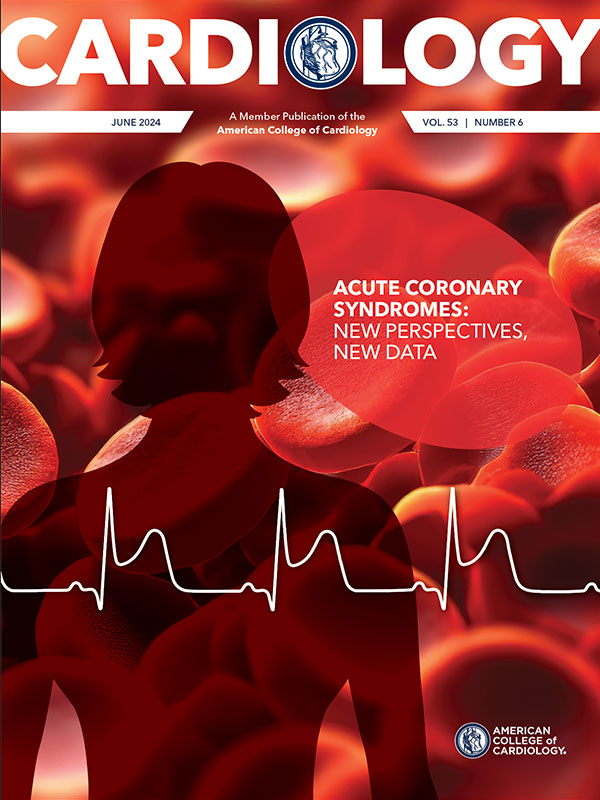Focus on Heart Failure | Heart Failure Highlights From ACC.24

ACC's Annual Scientific Session this year, as always, did not disappoint. With engaging sessions for multidisciplinary team members, late-breaking clinical trials and excellent company, it's just impossible to take in all the incredible science! For those who could not join us in Atlanta or were unable to physically appear in two competing sessions, we have you covered.
Here are some heart failure (HF) highlights from the meeting:
Unique Targets For Diabetic Cardiomyopathy
The ARISE-HF trial sought to test AT-001, a selective aldose reductase inhibitor, compared to placebo in patients with type 2 diabetes (T2D) and diabetic cardiomyopathy.1
Although many patients carry diagnoses of both T2D and HF, patients included in the study had Stage B HF as evidenced by structural heart disease but without symptoms of HF. Diabetic cardiomyopathy is thought to lead to impaired myocardial relaxation and elevated cardiac biomarkers.
Mechanistically, it is thought that multiple deleterious pathways are underlying the myocardial injury with fibrosis including hyperactivation of the polyol pathway. Aldose reductase catalyzes the rate-limiting step in this pathway which is why its inhibition is targeted in this condition.2
The primary endpoint in ARISE-HF was exercise capacity as determined by peak oxygen uptake (VO2) on cardiopulmonary exercise testing (CPET). Importantly, patients were stratified by region, CPET results at baseline, and the use of SGLT2 inhibitors or GLP1-RAs given their independent associations with improvement in exercise capacity.
A total of 691 individuals (50% women) were enrolled in this multicenter and multinational placebo-controlled, double-blind randomized clinical trial; there were three arms, two were treatment arms including both a 1,000 mg BID and 1,500 mg BID dose. There was no significant difference in peak VO2 between the groups. Notably, there was an improvement in peak VO2 in prespecified analyses among those who were not on SGLT2 inhibitors or GLP1-RAs at baseline.1
It is worthwhile to note that patients needed to have well-controlled blood pressure and a hemoglobin A1C <7.5%. As the authors suggest, the effects of AT-001 in a more generalizable practice or in patients with more advanced Stage B HF are unclear. Regardless, treating the underlying mechanism for diabetic cardiomyopathy is intriguing and requires further investigation.
Bottom Line: While AT-001 is not yet ready for prime time, the strategy of targeting the underlying mechanism in diabetic cardiomyopathy, particularly given the prevalence of these comorbidities in combination, is novel.
Microaxial Flow Pump Reduced Mortality in AMI-Cardiogenic Shock
Perhaps one of the most surprising and notable results of ACC.24 were those from the DanGer Shock trial. Randomized clinical trials are very difficult to perform in the cardiogenic shock population with prior studies such as the IABP-SHOCK II trial failing to show benefit.
Level Up on SGLT2 Inhibitors
Click here to access ACC's Heart Failure and SGLT2is: The New Pillar in Care initiative, including the free online course, clinician resources and CardioSmart patient resources.
Click here to download this free clinician infographic on SGLT2 inhibitors and the free pocket guide.
Visit ACC.org/ACC2024 for all the coverage from ACC.24, including news stories, trial summaries, visual abstracts, podcasts and video wrap-ups, and more.
Click here to access sessions from ACC.24 in ACC Anywhere. Attend ACC.24? Be sure to activate your one-year free subscription for ACC's conference video library.
The DanGer trial included 355 patients with STEMI and cardiogenic shock, defined as hypotension, lactic acidosis and systolic heart failure (left ventricular ejection fraction [LVEF] <45%).3 Patients were randomized to microaxial flow pump insertion with Impella CP in addition to standard care vs. standard care alone. Patients who had shock that had been ongoing for >24 hours were excluded, as were patients who were previously on mechanical circulatory support including Impella or veno-arterial extracorporeal membrane oxygenation (VA-ECMO). Patients in shock due to mechanical complications of MI or right ventricular failure were likewise excluded.3
The study population was quite sick; median LVEF was 25%, with 28% being SCAI stage D and 16% SCAI stage E. VA-ECMO was also used in 11.7% of the Impella CP group and 18.8% of the standard care arm.3
At six months, the use of Impella CP was associated with a significant reduction in all-cause mortality (hazard ratio [HR], 0.74; 95% CI, 0.55-0.99; p=0.04]. There was also a significantly lower likelihood of the composite of escalation of treatment to additional mechanical circulatory support, heart transplantation or death of any cause [HR, 0.72; 95% CI, 0.55-0.95]. The use of Impella CP was not without an increased risk of complications, namely, severe bleeding, limb ischemia, hemolysis, worsening aortic regurgitation or device failure, as well as need for renal replacement therapy.
Bottom Line: We finally have a randomized, controlled trial to confirm what we have suspected clinically – patients with cardiogenic shock in the setting of MI benefit from early initiation of mechanical circulatory support. These patients should be closely monitored for device complications such as bleeding, hemolysis and limb ischemia.
An Interatrial Shunt to Relieve HF?
The RELIEVE-HF study was the first placebo-controlled trial of interatrial shunting in patients with HF. The study included 508 patients with both reduced ejection fraction and preserved ejection fraction across 94 sites internationally. Approximately 60% had HFpEF while 40% had HFrEF. Patients were randomized to a shunt or sham procedure. There was no difference between groups for the primary endpoint which was a hierarchical composite of death from any cause, heart transplant or left ventricular assist device (LVAD), HF hospitalizations, worsening of outpatient HF events and change in quality of life. There was no difference in annualized rate of cardiac events. Notably, there was a significant improvement in quality of life across all groups including among those who received the sham procedure.
A prespecified analysis by LVEF was performed, suggesting that the shunt may be beneficial in patients with HFrEF who experienced reduction in HF hospitalizations. On the other hand, patients with HFpEF experienced increased rates of death and HF hospitalizations (the composite outcome occurred in 60.2% of the shunt group vs. 35.9% of the placebo group). The full study results have yet to be published.
Bottom Line: In 2022, we had the REDUCE LAP-HF II trial, which similarly evaluated a different interatrial shunt device, however only in patients with an LVEF ≥40%. The study investigators did not find any difference in HF events or health status. Although the overall RELIEVE-HF was similarly negative, the findings by EF are intriguing albeit exploratory. Further dedicated studies are needed in the HFrEF population to determine benefit.
New Therapy For Nonobstructive HCM
Although there has been increasing attention to novel therapies for obstructive hypertrophic cardiomyopathy, such as mavacamten, the Phase 2 IMPROVE-HCM trial focused on a cohort of patients with nonobstructive HCM. Participants were randomized to receive ninerafaxstat, a novel cardiac mitrotrope, or placebo. Ninerafaxstat helps encourage the use of glucose by myocardium as opposed to fatty acids.
Patients needed to have increased LV wall thickness with a peak LV outflow gradient <30 mm Hg and LVEF ≥50% with peak VO2 <80% of predicted for age and sex.4 Among 67 patients, there was a higher rate of adverse events in the ninerafaxstat group compared to placebo (11.8% vs. 6.1%) which was not significantly different. However, there were no changes in EF, blood pressure or heart rate. Notably, those in the ninerafaxstat arm did have significantly improved ventilatory efficiency (VE/VCO2 slope) at the end of the study period and decreased left atrial size.4 Among those with a KCCQ score of 80 or less, there was significant improvement in symptoms with ninerafaxstat. Given these encouraging findings, we should keep our eyes peeled for a Phase 3 study.
Semaglutide in Obesity-Related HF and Diabetes
Building on the STEP-HFpEF trial, the STEP-HFpEF DM trial presented at ACC.24 specifically focused on the effect of semaglutide on body weight and quality of life outcomes among patients with obesity, HFpEF and concomitant T2D. Patients needed to have a hemoglobin A1C ≤10% and an LVEF ≥45% in addition to prior HF hospitalization, elevated natriuretic peptide levels or elevated filling pressures by right heart catheterization.
The majority of patients (84%) were White, and 81% were on diuretics at baseline with only 33% on mineralocorticoid receptor antagonists (MRA) and another 33% on SGLT2 inhibitors. Perhaps unsurprisingly, similar to the original STEP-HFpEF trial, there was improvement in body weight and quality of life outcomes as measured by the 6-minute walk distance and KCCQ scores in the semaglutide arm.5
Similar to the discussion above about the ARISE-HF trial, patients who were not on an SGLT2 inhibitor at baseline appeared to derive greater benefit. It is worth noting, however, that the poor uptake of MRA and SGLT2 inhibitor use in this study leaves us wondering whether the results would have been modified by greater uptake of SGLT2 inhibitors.
Clinical Pearl: With the growing body of evidence, semaglutide should be considered part of guideline-directed medical therapy for patients with obesity and HFpEF.
Preventing HF Among Patients With Cancer?
The PROACT late-breaking clinical trial sought to investigate whether the ACE inhibitor enalapril would prevent anthracycline cardiotoxicity among individuals with breast cancer or non-Hodgkin lymphoma.6 This was a multicenter, randomized, open-label trial. Patients were required to have negative troponin levels at the start of the study. A total of 111 patients were included; 78% were women and 98% were White. The mean dose of anthracyclines received was 328 mg/m2. There were no significant differences in the proportion of patients who had positive Troponin T or troponin I levels at one month from the start of therapy. Similarly, there were no differences between the groups with respect to changes in LVEF or LV global longitudinal stain.

This article was authored by Ersilia M. DeFilippis, MD, FACC, an Advanced Heart Failure and Transplant Cardiology specialist and assistant professor of medicine, Division of Cardiology, Center for Advanced Cardiac Care, at Columbia University Irving Medical Center-New York Presbyterian Hospital.
References
- Januzzi JL, Butler J, Del Prato S, et al. Randomized trial of a selective aldose reductase inhibitor in patients with diabetic cardiomyopathy. J Am Coll Cardiol 2024; Published online April 8: doi:10.1016/j.jacc.2024.03.380
- Januzzi JL, Del Prato S, Rosenstock J, et al. Characterizing diabetic cardiomyopathy: baseline results from the ARISE-HF trial. Cardiovasc Diabetol 2024;23:49.
- Møller JE, Engstrøm T, Jensen LO, et al. Microaxial flow pump or standard care in infarct-related cardiogenic shock. N Engl J Med 2024;390:1382-93.
- Maron MS, Mahmod M, Abd Samat AH, et al. Safety and Efficacy of metabolic modulation with ninerafaxstat in patients with nonobstructive hypertrophic cardiomyopathy. J Am Coll Cardiol 2024;April 8: doi:10.1016/j.jacc.2024.03.387
- Kosiborod MN, Petrie MC, Borlaug BA, et al. Semaglutide in patients with obesity-related heart failure and type 2 diabetes. N Engl J Med 2024;390:1394-1407.
- Maier RH, Plummer C, Kasim AS, et al. Preventing cardiotoxicity in patients with breast cancer and lymphoma: protocol for a multicentre randomised controlled trial (PROACT). BMJ Open 2022;12:e066252.
Clinical Topics: Cardiac Surgery, Heart Failure and Cardiomyopathies, Invasive Cardiovascular Angiography and Intervention, Aortic Surgery, Cardiac Surgery and Heart Failure, Acute Heart Failure, Heart Transplant, Interventions and Structural Heart Disease
Keywords: Cardiology Magazine, ACC Publications, Heart Failure, Diabetes Mellitus, Type 2, Cardiomyopathy, Hypertrophic, Hypertrophic Cardiomyopathy, Shock, Cardiogenic, Heart Transplantation, ACC Annual Scientific Session, ACC24
< Back to Listings
